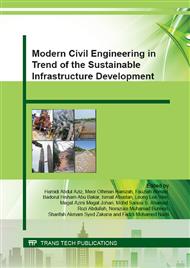p.617
p.623
p.629
p.634
p.640
p.649
p.655
p.661
p.668
Direct Determination of Groundwater Direction and Velocity Using Colloidal Borescope at Jenderam Hilir, Selangor
Abstract:
The colloidal borescope can be used for measuring groundwater flow directions and velocity. It is an integrated high-resolution flux gate compass with a high-magnification colloid-imaging camera that can measure flow at selected depths within a well. In this study, the colloidal borescope was used to determine flow direction and measure velocity during a pumping test for the riverbank filtration study in Jenderam Hilir, Selangor. During each measurement, the instrument, which monitored the movement of the suspended particles, was inserted into a well at a particular depth (screen well). The relative flow direction was determined by plotting the trajectory and speed of colloidal particles across the screen with AquaLITE Software, which determined the horizontal speed of the particles and flow speed. The groundwater flow pattern was dtermined at four boreholes in the study area, and the groundwater flow velocities were found ranging from 0.72 to 2.45 x (10-4) m/s. The direction of the groundwater flow at boreholes monitoring well 02 (MW02) and monitoring well 19 (MW19) was moved toward borehole pumping well (PW). The groundwater flow at monitoring well 01 (MW01) was moving toward the northwest of the study site which was parallel with the Langat river. The groundwater flow in borehole monitoring well A (MWA) was toward the southern part of the study site and was not affected by the pumping test activities at borehole monitoring well 03 (MW03).
Info:
Periodical:
Pages:
640-645
Citation:
Online since:
October 2015
Keywords:
Price:
Сopyright:
© 2015 Trans Tech Publications Ltd. All Rights Reserved
Share:
Citation:


